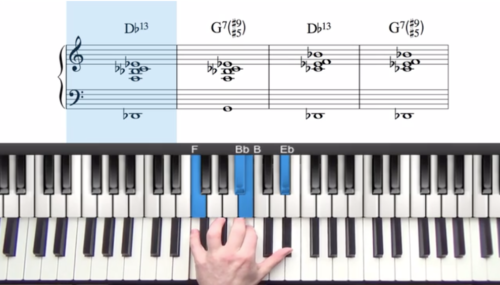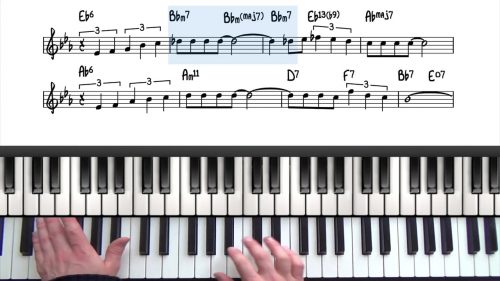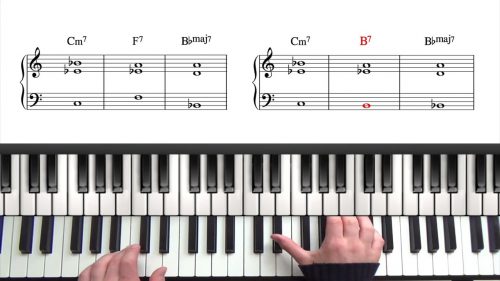Tritone Substitutions Fills – ‘Body & Soul’
In this lesson, we explore how to use tritone substitution to create interesting fills and melodic embellishments in ‘Body & Soul’. Tritone substitutions replace a dominant chord with a dominant chord a tritone (three whole steps) away, offering a fresh and colorful sound to standard 251 progressions.
By the end of this lesson, you’ll be able to confidently apply tritone subs in 2-5-1 progressions, experiment with altered chord voicings, and incorporate upper structure triads for harmonic movement.
What is Tritone Substitution?
A tritone substitution replaces a V7 chord with another dominant 7th chord located a tritone away (three whole steps).
For example, in a 2-5-1 progression:
- Standard: Eb-7 → Ab7 → Dbmaj7
- With a tritone sub: Eb-7 → D7 → Dbmaj7
Instead of playing Ab7, we replace it with D7, which shares key chord tones but introduces a different bass note and harmonic color. This creates a brighter, more open sound, especially when adding 9ths and 13ths.
Compare these two approaches:
-
Standard V7 chord (Ab7alt)
- Ab7(b9, #5) → Dbmaj7
- Sounds tense and angular.
- Tritone Substituted V7 chord (D9)
- D7(9) → Dbmaj7
- Sounds warmer and more open.
By swapping Ab7♯5♭9 for D9, we create a smoother sound and a sweeter resolution.
Upper Structure Triads & Fill Techniques
Another way to enhance tritone subs is by using upper structure triads to add harmonic depth.
For example:
- Over Ab7#9#5, play an E triad in the right hand.
- Over D13#11, play an E triad for a bright and uplifting sound.
Though the triad stays the same, its function changes based on the bass note — creating vastly different harmonic colors.
When Tritone Subs Don’t Work
Not all dominant chords work well with a tritone sub. Sometimes, the melody or harmonic context clashes with the substitution.
For example:
- Substituting Bb7 for E7 in the first bar creates an unnatural sound.
- Likewise, replacing Gb7 with C7 can sound out of place.
Tritone subs work best in 2-5-1 progressions but require a trial and error approach to find what works best.
Practice Tips
-
Start with Simple 2-5-1 Progressions – 251 progressions are an ideal harmonic situation to explore tritone substitution possibilities.
-
Compare Altered & Non-Altered Sounds – Compare the original V7 chord and its tritone substitute to hear the contrast.
-
Use Upper Structure Triads – Introduce Upper Structure Triads to add more depth and impact to tritone substitutes.
-
Different Registers – Play tritone subs in different octaves to see where they sound best.
- Trust Your Ears – Some substitutions will sound great, others won’t. Always listen critically.







Hello Hayden,
I have really enjoyed this course!
Do you know when the next part will be available (diminished scales and fills)?
Thank you! :)
Hi Matthieu,
I’m glad you enjoyed the course – this is one of my favourite tunes to play.
Yes it’s on my to-do-list to add some more videos to this course. There are so many methods for creating fills and reharmonisations – especially with this tune as it is harmonically rich and sophisticated with many key changes.
A nice place to add a diminished scale run/fill is over the sequence F-7 to Edim7 in bar 4.
Edim7 is effectively a rootless C7 chord, and so the find the scale by alternating half and whole steps starting from C. eg. C-Db-Eb-E-F#-G-A-Bb-C etc…
I like to add this diminished scale run for that bar, even starting the scale over the F-7 which technically clashes as we have A and E which are the major 3rd and 7th of F-, but the scale still works if we play it quickly and works perfectly to transition to Edim7. We resolve to Eb-7 in bar 5 and so try to finish the scale run on a chord tone, or the 9th of Eb-7 is also a nice tone to land on.
Remember that we can add chromaticism and enclosures when moving to Eb-7 in bar 5.
Here is a playlist that I created for this tune: open.spotify.com/playlist/2OUfKT4dHosZnREvO8ThHG?si=aec17feff44949a0 – mostly solo piano recordings.
The Bud Powell recording has some interesting diminished patterns in his solo where he often harmonises the diminished scale in 3rd intervals over various chords in the form. I was planning to incorporate some of those ideas into the lesson on diminished fills.
If you don’t have Spotify you can also search for the song and musician to find the recordings on YouTube.
But yes thanks for reminding me about the next lessons in this course and I will record them ASAP.
I’d like to add a improvisation module which covers some ideas and drills for improvised solos.
Cheers,
Hayden
P.S. – I have a couple of seminars on this tune which you might find interesting if you haven’t already watched them:
pianogroove.com/live-seminars/solo-jazz-piano-secrets/ – this is a more rubato and laid back way to arrange the tune.
pianogroove.com/live-seminars/beegie-adair-stride-analysis/ – this seminar covers many of the concepts that I cover in this course, but I’m sure there are some additional ideas and insights in there too.
Hi Hayden,
Thank you very much for this detailed answer!
I will check the Spotify playlist and go through the seminars once again :)
Looking forward for the next lessons. I really enjoy the way the courses are structured.
Ciao,
Matthieu